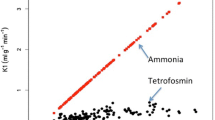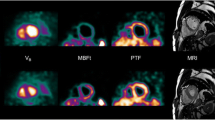Abstract
Background
Positron emission tomography scanners with retractable septa allow both 3-dimensional (3D) and 2-dimensional (2D) acquisition modes. The study aim was to directly compare 2D and 3D acquisition modes for the evaluation of absolute myocardial blood flow (MBF) over a wide range of flow values.
Methods and Results
Instrumentation was used in 4 dogs to reduce the left circumflex artery lumen by greater than 75%. During infusion of adenosine, MBF was measured with both 2D and 3D dynamic acquisition and both oxygen 15 water and nitrogen 13 ammonia. Injected activities were 333 MBq and 111 MBq for 2D acquisition and 3D acquisition, respectively. Data were reconstructed by analytic methods, and MBF was assessed by use of an 18-segment model. MBF values ranged from 0.4 to 5.8 mL · g-1 · min-1 with O–15 water and from 0.3 to 3.9 mL g-1 min-1 with N-13 ammonia. No significant differences were observed in absolute MBF values obtained with the 2 acquisition modes, regardless of the flow tracer used. Two-dimensionally and three-dimensionally derived MBF values were significantly strongly correlated by use of both O-15 water (y = 0.98x + 0.18, r = 0.87, P < .001) and N-13 ammonia (y = 0.99x + 0.09, r = 0.95, P < .001).
Conclusion
Quantification of MBF in dogs with 3D positron emission tomography provides results similar to those obtained with the 2D technique, despite a lower activity being injected.
Similar content being viewed by others
References
Shah A, Schelbert HR, Schwaiger M, Henze E, Hansen H, Selin C, et al. Measurement of regional myocardial blood flow with N-13 ammonia and positron-emission tomography in intact dogs. J Am Coll Cardiol 1985;5:92–100.
Nienaber CA, Ratib O, Gambhir SS, Krivokapich J, Huang SC, Phelps ME, et al. A quantitative index of regional blood flow in canine myocardium derived noninvasively with N-13 ammonia and dynamic positron emission tomography. J Am Coll Cardiol 1991;17:260–9.
Bol A, Melin JA, Vanoverschelde JL, Baudhuin T, Vogelaers D, De Pauw M, et al. Direct comparison of [13N]ammonia and [15O]water estimates of perfusion with quantification of regional myocardial blood flow by microspheres. Circulation 1993;87:512–25.
Bergmann SR, Herrero P, Markham J, Weinheimer CJ, Walsh MN. Noninvasive quantitation of myocardial blood flow in human subjects with oxygen-15-labeled water and positron emission tomography. J Am Coll Cardiol 1989;14:639–52.
Araujo LI, Lammertsma AA, Rhodes CG, McFalls EO, Iida H, Rechavia E, et al. Noninvasive quantification of regional myocardial blood flow in coronary artery disease with oxygen-15-labeled carbon dioxide inhalation and positron emission tomography. Circulation 1991;83:875–85.
Nitzsche EU, Choi Y, Czemin J, Hoh CK, Huang SC, Schelbert HR. Noninvasive quantification of myocardial blood flow in humans. A direct comparison of the [13N]ammonia and the [15O]water techniques. Circulation 1996;93:2000–6.
Bergmann SR, Fox KA, Rand AL, McElvany KD, Welch MJ, Markham J, et al. Quantification of regional myocardial blood flow in vivo with H215O. Circulation 1984;70:724–33.
Sossi V, Oakes TR, Ruth TJ. A phantom study evaluating the quantitative aspect of 3D PET imaging of the brain. Phys Med Biol 1998;43:2615–30.
Trebossen R, Bendriem B, Ribeiro MJ, Fontaine A, Frouin V, Remy P. Validation of the three-dimensional acquisition mode in positron emission tomography for the quantitation of [18F]fluoro- DOPA uptake in the human striata. J Cereb Blood Flow Metab 1998;18:951–9.
Lartizien C, Comtat C, Kinahan PE, Ferreira N, Bendriem B, Trebossen R. Optimization of injected dose based on noise equivalent count rates for 2- and 3-dimensional whole-body PET. J Nucl Med 2002;43:1268–78.
Schafers KP, Spinks TJ, Camici PG, Bloomfield PM, Rhodes CG, Law MP, et al. Absolute quantification of myocardial blood flow with H2O-15 and 3-dimensional PET: an experimental validation. J Nucl Med 2002;43:1031–40.
Wienhard K, Dahlbom M, Eriksson L, Michel C, Bruckbauer T, Pietrzyk U, et al. The ECAT EXACT HR: performance of a new high resolution positron scanner. J Comput Assist Tomogr 1994; 18:110–8.
Grandin C, Wijns W, Melin JA, Bol A, Robert AR, Heyndrickx GR, et al. Delineation of myocardial viability with PET. J Nucl Med 1995;36:1543–52.
Kinahan PE, Rogers JG. Analytic three-dimensional image reconstruction using all detected events. IEEE Trans Nucl Sci 1990;36:964–88.
Watson CC. New, faster, image-based scatter correction for 3D PET. IEEE Trans Nucl Sci 2000;47:1587–94.
Coppens A, Sibomana M, Bol A, Michel C. MEDIMAN, an object oriented approach for medical image analysis. IEEE Trans Nucl Sci 1993;40:950–5.
Wu HM, Hoh CK, Buxton DB, Kuhle WG, Scheibert HR, Choi Y, et al. Quantification of myocardial blood flow using dynamic nitrogen-13-ammonia PET studies and factor analysis of dynamic structures. J Nucl Med 1995;36:2087–93.
Ahn JY, Lee DS, Lee JS, Kim SK, Cheon GJ, Yeo JS, et al. Quantification of regional myocardial blood flow using dynamic H2(15)O PET and factor analysis. J Nucl Med 2001;42:782–7.
Gerber BL, Melin JA, Bol A, Labar D, Cogneau M, Michel C, et al. Nitrogen-13-ammonia and oxygen-15-water estimates of absolute myocardial perfusion in left ventricular ischemic dysfunction. J Nucl Med 1998;39:1655–62.
Bland JM, Altaian DG. Statistical methods for assessing agreement between two methods of clinical measurement. Lancet 1986; 1:307–10.
Knesaurek K, Machac J, Krynyckyi BR, Almeida OD. Comparison of 2-dimensional and 3-dimensional82Rb myocardial perfusion PET imaging. J Nucl Med 2003;44:1350–6.
Votaw JR, White M. Comparison of 2-dimensional and 3-dimensional cardiac 82Rb PET studies. J Nucl Med 2001;42:701–6.
Author information
Authors and Affiliations
Corresponding author
Rights and permissions
About this article
Cite this article
Roelants, V., Bol, A., Bernard, X. et al. Direct comparison between 2-dimensional and 3-dimensional PET acquisition modes for myocardial blood flow absolute quantification with O-15 water and N-13 ammonia. J Nucl Cardiol 13, 220–224 (2006). https://doi.org/10.1007/BF02971246
Received:
Accepted:
Issue Date:
DOI: https://doi.org/10.1007/BF02971246




